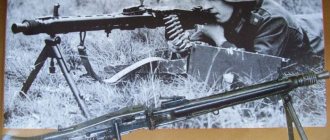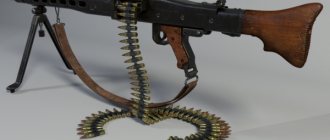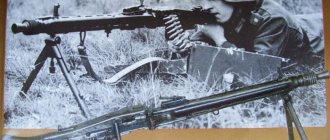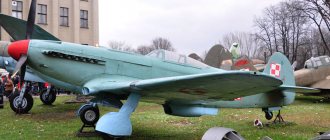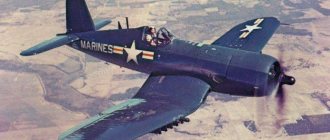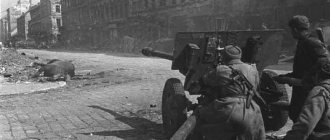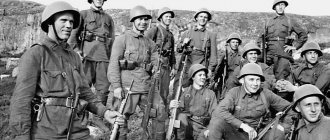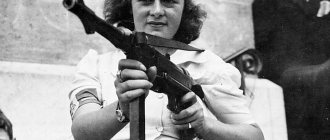ShVAK aircraft cannon. Weapons of Soviet aces
Large-caliber machine guns and the first cannons appeared on board aircraft during the First World War, but then these were only timid attempts to increase the firepower of the first aircraft. Until the mid-30s of the 20th century, this weapon was used in aviation only sporadically. The real heyday of aircraft rapid-fire guns occurred in the pre-war years and during the Second World War. In the Soviet Union, one of the most famous aircraft guns, which was installed on a huge number of aircraft from I-16 to La-7, and was used as part of turrets on Pe-8 and Er-2 bombers, was the 20-mm ShVAK aircraft automatic gun (Shpitalny -Vladimirov Aviation Large-caliber). Mainly, this gun was used to arm Soviet fighters.
At the same time, none of the Soviet aircraft guns could boast of such production volumes as the ShVAK. In 1942, a rather difficult year for the entire country, Soviet enterprises were able to produce 34,601 aircraft guns of this type. The production of ShVAK was established at the Tula Arms, Kovrov Arms and Izhevsk Machine-Building Plants. In total, more than 100 thousand copies of the 20-mm ShVAK aircraft gun were manufactured in the USSR, taking into account the pre-war production. Its slightly modified version was also used to arm light tanks, for example, the mass-produced T-60 tank. Considering the volume of production and use of this artillery system, it is rightly classified as a “weapon of Victory.”
ShVAK is the first Soviet automatic aircraft gun of 20 mm caliber. It was put into service in 1936 and was produced until 1946, when the last 754 guns of this type were assembled. The aircraft cannon was produced in four versions: wing-mounted, turret-mounted, motor-cannon and synchronous. The motor gun was distinguished by the presence of a longer barrel and a shock absorber. In its design, the ShVAK was completely similar to the large-caliber 12.7-mm machine gun of the same name, which was put into service back in 1934. The only difference was in the diameter of the barrel used. Tests of the ShVAK heavy machine gun demonstrated to the designers that, thanks to the existing safety margin, the caliber of the system can be increased to 20 mm without changing the dimensions of the moving system, simply by replacing the barrel. The ShVAK gun had a belt feed; the reloading process was carried out mechanically or pneumatically.
ShVAK aircraft cannon
Synchronized ShVAK on the La-5 fighter
For the first time, a new gun was installed on an IP-1 fighter designed by Dmitry Pavlovich Grigorovich. In the summer of 1936, it was presented to the Air Force Research Institute for state testing. At the same time, it took about four years to fine-tune it. Only in 1940 did the ShVAK cannon designed by Boris Gavrilovich Shpitalny and Semyon Vladimirovich Vladimirov begin to be mounted on Soviet fighters, both in the cylinder block of the M-105 aircraft engine (motor-gun) and in the wing. The combat debut of the new Soviet aircraft gun came in 1939. ShVAK air cannons were mounted on I-16 fighters, which were used in battles with the Japanese at Khalkhin Gol.
Structurally, the 20-mm ShVAK aircraft gun repeated the previous models of the ShKAS and ShVAK machine guns (12.7 mm). The gun's automation operated on the basis of a gas outlet. The air cannon had a fixed barrel, which, when assembled, was connected to the assembled box using a locking insert. As in previous developments, the 20-mm ShVAK aircraft gun used the highlight of the Shpitalny systems - a 10-position drum mechanism for the gradual removal of the cartridge from the belt, thanks to its use the high rate of fire of the system was ensured. But this operating scheme required the use of its own welted cartridge with a protruding flange-rim, which clings to the screw groove of the gun drum. For this reason, no other type of cartridge could be used in Shpitalny's weapon.
Today we can safely say that the idea of unifying weapons for different calibers is quite sound. Many systems in world practice followed the same path; today, in the first quarter of the 21st century, multi-caliber weapons are experiencing a real heyday. However, in the case of Shpitalny’s models, everything was not so clear. The thing is that his first project for the ShKAS aviation machine gun was built around an existing 7.62x54R rifle caliber cartridge with a rim, which was completely justified in order for the machine gun to achieve a high rate of fire. But the ShVAKs already demanded from the Soviet industry the creation of fundamentally new ammunition of a welt design. In the version with a 12.7 mm machine gun, such a solution turned out to be unsuccessful. This caliber was intended to be universal; it was planned to be used not only in aviation. With the Degtyarev 12.7x108 mm cartridge already existing at that time, which was more convenient for magazine feeding, even the assertiveness that was characteristic of Shpitalny was not enough to push through the parallel production of a similar 12.7x108R welt cartridge. Such a cartridge was produced in the USSR for a short time in parallel with the production of a small series of ShVAK heavy machine guns. In the end, it was simply discontinued.
Wing ShVAK on the I-16 type-17 fighter
But the 20-mm version of ShVAK had a much more successful fate. At the time of the development of this aircraft gun, there were simply no other 20-mm cartridges in the Soviet Union. As a possible option, the production of the “Long Solothurn” - a powerful Swiss ammunition of 20x138R caliber, for which the Atsleg AP-20 universal assault rifle was created in KB-2, was considered, however, in general, the niche of 20-mm ammunition in the USSR was not filled, which completely freed up the hands to the creators of the ShVAK air cannon.
Other negative aspects of the unification of the 12.7-mm and 20-mm versions of ShVAK, experts include the fact that Vladimirov’s group, trying to maintain a single design of the components of the two aircraft systems, was forced to equalize the geometric dimensions along the length of the two types of cartridges. The length of both cartridges was 147 mm, which ensured a single design of the most labor-intensive component of the system in production - the feed drum structure. However, if the 12.7 mm cartridge was powerful enough for its class, the new 20x99R turned out to be one of the weakest 20 mm caliber ammunition among its foreign counterparts.
Ultimately, the motor cannon formed the basis of the armament of the Soviet Yak and LaGG fighters; in the wing version, it was also used on the first Il-2 attack aircraft with ammunition of 200 rounds per barrel. The beginning of the Great Patriotic War spurred both the mass production of 20-mm ShVAK air cannons and the introduction of synchronized versions of the gun, which began to appear on Lavochkin fighters in 1942, and were installed on certain series of the MiG-3 fighter.
Aircraft engine VK-105PF with ShVAK motor-cannon
But the turret version of the ShVAK could not boast of a successful fate and did not take root in Soviet aviation. Too heavy and bulky, it did not fit into the light turret mounts of our bombers. Its use was extremely limited. The gun was installed on the MTB-2 (ANT-44) flying boat, as well as on the Myasishchev DB-102 experimental bomber. Almost the only production combat aircraft that was equipped with a standard ShVAK turret version was the Pe-8 (TB-7) heavy bomber, the production of which was practically one-off throughout the war years. And at the very end of the war, a ShVAK cannon was also installed on the upper turret of the Er-2 bomber.
Thus, the main consumer of ShVAK aircraft guns throughout the entire period of their production was Soviet fighter aircraft. ShVAK was installed on the I-153P, I-16, I-185, Yak-1, Yak-7B, LaGG-3, La-5, La-7 and Pe-3 fighters. When the I-16 fighter was discontinued from production, and the Il-2 attack aircraft began to be rearmed with the new 23-mm VYa aircraft cannon, the production of the wing version of the ShVAK was almost completely curtailed. In 1943 alone, 158 of these guns were produced to re-equip Lend-Lease Hurricanes, where they were installed instead of 7.7 mm Browning machine guns. And at the end of the war, the wing version of the cannon again found its use, becoming the offensive weapon of the Tu-2 twin-engine high-speed bomber.
At the same time, the ShVAK motor gun, with some changes in design in 1941-42, was mounted on light tanks T-30 (modification of T-40) instead of the 12.7-mm DShK machine gun, which made it possible to significantly increase the power of their fire impact on the enemy and gave tankers the opportunity to hit lightly armored enemy vehicles (armor penetration - up to 35 mm with a sub-caliber projectile), anti-tank guns, machine gun nests and enemy manpower. A version of the gun designated ShVAK-tank or TNSh-20 (Nudelman-Shpitalny tank) was serially installed on T-60 light tanks.
TNSh-20 gun in the T-60 light tank
In May 1942, specialists from the Air Force Research Institute came to the conclusion that the 20-mm ShVAK aircraft cannon works flawlessly on the I-16 fighters (in the wing), Yak-1 and LaGG-3 (through the gearbox). The projectile of this gun is effective against enemy aircraft, armored cars, light tanks and vehicles, and railway gas tanks. The ShVAK cannon shell is not effective against medium and heavy tanks. In general, the ShVAK projectile was inferior in weight, and therefore explosive efficiency, to the shell of German aircraft guns of the same caliber (the ShVAK projectile weighed 91 grams, and the German MG FF aircraft gun weighed 124 grams). It was also noted that in terms of effectiveness against targets, the ShVAK was significantly inferior to the 23-mm VYa aircraft cannon.
Comparing the Soviet ShVAK with the German MG FF aircraft cannon, you come to the conclusion that the German cannon, which used the recoil energy of a free shutter (on the ShVAK - a gas outlet), had an advantage only in the weight and breaking force of the shells used. At the same time, the initial projectile speed of the German gun was at least 220 m/s less, but the second salvo for wing-mounted aircraft guns was almost the same. At the same time, the MG FF was 15 kg lighter, including due to the use of a shorter barrel. At the same time, this advantage of German guns was lost with the advent of the new B-20 aircraft gun in the USSR.
Today it is quite difficult to objectively assess the value of the 20-mm ShVAK aircraft gun. Of course, it had a certain set of shortcomings - weak ammunition with poor ballistics, operational and technological complexity, which, especially at the initial stage of production, led to the high cost of the gun. At the same time, the first drawback was easily compensated for by the enormous rate of fire of the ShVAK, which reached 800 rounds per minute, and the cost reduction occurred due to the establishment of mass production and adaptation of industry. It is worth noting that in terms of rate of fire, the ShVAK had no equal among the mass-produced aircraft guns of other countries. True, the synchronized versions, which were installed on the excellent Soviet fighters La-5 and La-7, depending on the engine operating mode, had a lower rate of fire - 550-750 rounds per minute.
Comparison of the 20x99R cartridge with other ammunition
In any case, we can say that the Shpitalny-Vladimirov air cannon became one of those iconic weapons of the Red Army that were able to ensure victory for our country in the Great Patriotic War. According to fighter pilots of those years, the power of even the relatively weak 20-mm shells of the ShVAK cannon was enough to combat any Luftwaffe aircraft. Of course, if Germany had massively acquired heavy bombers or Soviet aviation had to face armadas of American “flying fortresses” in the sky, our fighters would have had a hard time, but in reality none of this happened.
It is also important to remember that in the Soviet Union there was simply no alternative to ShVAK for a long time. The development of the promising B-20 aircraft cannon designed by Mikhail Evgenievich Berezin, also created by him on the basis of a heavy machine gun and based on the same principle of operation as the ShVAK, was seriously delayed due to the illness of the designer. For this reason, the ShVAK aircraft cannon, despite its “weakness,” remained the main weapon of fighter aircraft during the Great Patriotic War.
The training of Soviet pilots, which grew during the war and made it possible to effectively use the weapons at their disposal, also played a significant role. It is no secret that the personnel of the Red Army Air Force, who met the war on June 22, 1941, had extremely low qualifications and an almost complete lack of experience in the combat use of their aircraft. The only exceptions were command personnel who managed to go through Spain, Khalkhin Gol, and the winter war with Finland, but there were few such pilots. And they, basically, passed on the accumulated experience in accordance with the training “Course for the combat use of fighter aircraft.” This was confirmed by the consumption of ammunition against air targets, which varied throughout the war from its first months to its last. If at the initial stage of the war, Soviet pilots often opened fire on the enemy from a distance of 300-400 meters, then already in 1942, having gained experience, from a distance of 100-150 meters, and sometimes from 50 meters. This led to an increase in shooting accuracy and a reduction in ammunition consumption. In relation to the ShVAK aircraft cannon, this increased the effectiveness of its projectiles. When the enemy plane turned into a colander, the lower explosive force of the Soviet cannon shells was no longer significant.
The wing of a German Bf.109 fighter after being hit by 20-mm ShVAK shells
During the pre-war period and the years of World War II, Soviet industry produced more than 100 thousand ShVAK aircraft cannons, which makes it one of the most popular artillery systems in the history of aviation. Production of ShVAK was discontinued only in 1946. It was replaced by the more advanced B-20 aircraft cannon, which, while possessing similar combat characteristics, was more reliable and lighter.
Performance characteristics of ShVAK: Length/weight: Wing version – 1679 mm/40 kg. Turret version – 1726 mm/42 kg. Motor gun – 2122 mm/44.5 kg. The stroke length of the moving parts is 185 mm. Rate of fire – 700-800 rounds/min. The initial velocity of the projectile is 815 m/s. Cartridge – 20x99 mm R.
Sources of information: https://www.airwar.ru/weapon/guns/shvak.html https://nvo.ng.ru/armament/2018-08-10/13_1008_weapons.html https://www.airbase.ru /alpha/rus/sh/shvak/20/shvak.html Materials from open sources
History of creation
From the moment the aircraft were put into service, the question of their armament arose.
Initially, fighter planes were equipped with conventional machine guns, only adapted to the needs of aviators, such as the PV-1, an aircraft machine gun created on the basis of a conventional Maxim, as well as turret-mounted DAs based on the infantry DP-27. But the speed increased, and the materials used for the fuselage and wing of the aircraft also changed. The war in the air made its demands. In order to damage or shoot down an enemy aircraft flashing in the sight, it was necessary to put as many bullets into it as possible and destroy its structure.
But at the same time, aviation weapons had to meet the following requirements:
- reliable automation, reloading manually or using a pneumatic system;
- increased rate of fire of aircraft weapons, the more bullets fired per second, the greater the probability of a hit;
- increased hit efficiency, use special bullets with an incendiary or explosive charge for this, which in turn requires an increase in caliber; rifle bullets have too little destructive effect;
- belt ammunition, ideally, the magazine has a limited capacity, moreover, its reliability depends on a number of rubbing parts, which makes it difficult to use at altitude, at subzero temperatures;
- compactness, low weight and minimal recoil, the weapons should not destroy the structure of the aircraft, and besides, the space for placing weapons is very limited.
Based on these requirements, Soviet engineers began to develop aviation weapons, and thus the record-breaking ShKAS machine gun, designed by Shpitalny and Komaritsky, was created. Its rate of fire reached 1200 rounds/min.
Let us note one of the disadvantages of this system - the use of a 7.62 mm welted cartridge; a non-welted cartridge could not be used in this scheme, since the basis of the ShKAS machine gun was the placement of the cartridge in the drum, which fed the cartridges into the chamber.
In 1932, Vladimirov’s group (the future designer of the KPVT-14.5 machine gun) began developing a large-caliber machine gun chambered for 12.7 mm, and then they encountered a problem; the fact is that the domestic 12.7x108 mm cartridge, adopted for service, did not had a welt.
But releasing a second cartridge, but with a welt, for the same caliber was irrational from an economic point of view. For this reason, work on the 12.7 mm ShVAK machine gun chambered for 12.7x108R was suspended.
It is worth noting that for a 20 mm air cannon a weight of 40 kg was quite adequate, but for a 12.7 mm heavy machine gun this weight was too high. And the weight characteristics of weapons are among the most important in aviation.
But the 20 mm air cannon, developed on our own initiative, came in handy. The operating principle of the air cannon was also based on a 10-position drum. The 20x99R cartridge, although distinguished by weak ballistic data and low power, fully met the requirements of the Air Force.
As a result, the ShVAK aviation rapid-fire cannon was adopted into service, in two versions - the turret-mounted TP-20 and the wing-mounted version of the KP-20. Later, a synchronous version and a motor-gun, designed to fire through the hollow propeller shaft, were developed and adopted.
This is how the first rapid-fire cannon designed by Shpitalny and Vladimirov, the ShVAK, appeared in the arsenal of domestic aviation.
Device
The 152-mm howitzer gun D-20 contains a semi-automatic vertical wedge breech, which is of the mechanical type. Despite the fact that the D-20 and D-74 use the same carriage, in both artillery guns it has different front holder diameters and recoil spindle profiles. In the D-20 it is hydraulic, equipped with a spring compressor. The filler for the brake was Steol-M, which is also provided for the hydropneumatic knurler. To fasten the brake cylinders, special barrel clips have been developed that roll away simultaneously with the barrel itself.
The 152 mm howitzer gun is mounted on welded box frames. With the help of hose rollers, artillery pieces are rolled over short distances. Wheels of YAZ trucks are used as the main wheels.
Historical reference
Three-gun La-7
The B-20 cannon was created by M.E. Berezin by converting his 12.7 mm UB machine gun to the 20 mm ShVAK cartridge for a competition. The B-20 was adopted by GKO Resolution No. 6681 “On the adoption by the Red Army Air Force of the lightweight 20 mm caliber B-20 aviation automatic cannon designed by Comrade Berezina” dated October 10, 1944. It is known that from March 1945 until the end of the war, 368 “three-gun” La-7s were produced, all at plant No. 381. But after installation, it became clear that the gun did not meet the reliability requirements. During tests at the Air Force Research Institute in the fall of 1945, a gun from three “three-point” La-7 aircraft (each with three B-20s) that took part in the tests, none of them managed to achieve the required figure of 5000 shells fired from one aircraft without failures - on average this figure was 3200 shells from the aircraft. According to Shirokorad, 9,515 copies of the B-20 were produced during the entire period of the war, and 15,352 copies throughout the entire period. According to Novikov’s recollections, the main manufacturer of guns was the Kovrov Plant No. 2 named after. Kirkizh, which fired about 9 thousand guns during the war. According to A.S. Yakovlev, during the war alone, as many as 32 thousand guns were manufactured.
Gun modifications:
- B-20M
– motor gun (for installation in the camber of the cylinder block). - B-20S
– version with synchronizer (for firing through a propeller). - Wing version of the cannon
, but there is no data about it (not confirmed). - B-20T-E
- used as part of the AAU (Aviation Artillery Mount) VU-9 on serial Il-10s since August 1945. - B-20E
(electrified) - used as defensive weapons on the Tu-4 strategic bomber. - In 1951, Plant No. 23 produced Tu-2S bombers with B-20EN
. The following year, these guns were installed on Il-10M attack aircraft as part of the VU-9M aviation gun mount, a modification of the VU-9 with an electric drive.
Links[edit]
- ^ ab Shirokorad, pp. 74-75
- ^ abc Bortsov A.Yu. "Five Line", Master Gun
Issue 110, May 2006, pp. 56-62 - Chinn, page 93
- Chinn, vol. 2, pp. 178-180.
- ^ a b Shirokorad, p. 75
- Chinn, page 72 for notations; Weights and lengths for three of the four options are given in Shirokorad, pp. 75-76.
- Chinn, pp. 85-86
- ^ a b Chinn, page 85
- ^ a b Chinn, page 82
- Chinn, pp. 82-84
- ^ a b Shirokorad, p. 77
- Maslov M. A. (2008). I-16 fighter. The restive “donkey” of Stalin’s falcons (in Russian). Yauza / Collection / EKSMO. pp. 55–57. ISBN 978-5-699-25660-0.
- https://www.airwar.ru/enc/fww2/i28.html
- ↑
Shirokorad, village 77 mentions all of the above except the Yak-3. - ↑
Shirokorad, village 77; although it lowers the IL-2 - ↑
Shirokorad, pp. 76-77
- Shirokorad A.B. (2001) History of aviation weapons
Harvest (Shirokorad A.B. (2001)
History of aviation weapons
Harvest. ISBN 985-433-695-6) (
History of aviation weapons
) - Call, Christian (2009). Soviet Cannon - a comprehensive study of Soviet weapons and ammunition in calibers from 12.7 mm to 57 mm. Austria: Coll. p. 117. ISBN 978-3-200-01445-9.
- Chinn, George M. The Machine Gun, Volume II, Part VII. US Department of the Navy, 1952.
Design and principle of operation
The gun's automation is based on the principle of using the energy of powder gases. When fired, the powder gases, passing through the barrel bore, pass into the gas outlet tube, pushing the bolt frame rod, and it, in turn, transfers energy to the operation of the gun mechanisms:
- The barrel is unlocked, the bolt frame rolls back under the action of powder gases, the cartridge case is simultaneously pulled off and removed from the chamber, and the trigger mechanism is cocked. The drum turns. The return spring and buffers are compressed.
- At the same time, the comb drum grabs a new cartridge with a tape, rotates, shifting the cartridge rand along a spiral groove, bringing it closer to the chamber, and gradually pulling it out of the tape. The belt link is thrown out of the mechanisms.
- The bolt, having rolled back, begins to move forward under the action of the buffers and the return spring. Along the way, the bolt captures the cartridge from the comb drum and sends it into the chamber, once again turning the drum. The firing pin is released, the next shot is fired, and the cycle repeats again.
In reality, the shot pattern looks somewhat more complicated. But the main feature of ShKAS and ShVAK is the use of a comb drum, which gradually feeds the cartridge to the chamber. It was the use of this mechanics that gave these types of weapons the highest rate of fire.
Separately, it is worth noting the work of the gas regulator, it was he who controlled the rate of fire of the ShVAK. When the aircraft gun was released from the factory, this regulator had four hole positions - 5 mm, 4.5, 3.5 and 3 mm. The factory setting was 5mm.
After firing 180-230 rounds, due to some wear on the mechanisms, the rate of fire of the gun increased to critical levels, 800-850 rounds/min, instead of the technical 700.
After this, the weapon had a lifespan of 100 rounds; only after this number of rounds had been fired, the regulator had to be set to the next division. At 3.5, the air cannon worked until the gas piston was replaced. Then the regulator was set to 4.5 and the cycle was repeated.
Such technical details, which took into account the service life of the weapon, somewhat complicated the care of the weapon, but on the other hand, it simplified its repair and maintenance.
Ammunition[edit]
| This section requires additional links for verification . |
The ShVAK ammunition consisted of a mixture of fragmentation incendiary and armor-piercing incendiary shells.
| USSR designation | US abbreviation | Bullet weight [g] | Initial bullet speed [m/s] | Description |
| OZ | University | 96,0 | 770 | Nose fuze, 2.8 g HE + 3.3 g incendiary |
| OST | VUZ-T | 96,5 | 770 | Nose fuze, 2.8 g HE + 3.3 g incendiary, tracer |
| FROM | HE-Frag. | 91,0 | 790 | Nose fuze, 6.7 g HE, fragmentation grooves on the cartridge case |
| OFZ | HEI-Frag. | 91,0 | 790 | Nose fuze, 0.8 g HE + 3.8 g incendiary, fragmentation grooves on the cartridge case |
| BZ | API-HC | 96,0 | 750 | Mild steel projectile body with a hardened steel core surrounded by 2.5g incendiary, screwed onto an aluminum or bakelite ballistic base |
| BZ | API-HC | 99,0 | 750 | Same as above, but with crimped steel nose cap |
| BZ | API | 96,0 | 750 | Solid steel shot with incendiary mixture in a crimped steel cap |
| BZT | PIT | 96,0 | 750 | Same as above, but with a tracer in the base cavity |
| PU | TP | 96,0 | 770 | Inert-charged HEI projectile with dummy fuze |
| PUT | TP-T | 96,5 | 770 | An empty projectile with a solid head and a compressed tracer in the base cavity |
There were also problems with the development of ammunition. There have been cases of premature burnout of ammunition in the barrel. The problem was first solved in 1936 by replacing the Model MG-3 fuze with the Model MG-201, but the problem was not completely eliminated until the introduction of the K-6 fuze in 1938, which reliably prevented shells from firing until they were 30 up to 50 cm from the trunk. [16]
Combat use
Almost all released air cannons found their main application on fighter aircraft. The 20 mm ShVAK was first installed on the I-16, an experimental model today known as the Type 12. This attempt was unsuccessful due to placement.
Later they were installed in the console of the I-16 type 17 and type 28. These aircraft modifications were highly valued by pilots. Suffice it to say that it was on this I-16 that the ace of the Red Banner Northern Fleet B.F. Safonov. won several victories.
Synchronous versions found application on the La-5 and La-7, in addition they were installed on. Turret versions of the guns were intended to arm heavy bombers, primarily the Pe-8 (TB-7), and later the aircraft guns were installed on the Er-2.
Wing cannons were installed on the Il-2, but due to their not entirely successful placement, jamming was common; subsequently the ShVAK was replaced with the more powerful VYA-23.
An interesting story happened in 1942. The Hurricanes that arrived under Lend-Lease were distinguished by their heavy weight, sluggish acceleration characteristics and “powerful” armament of 8 or even 12 Vickers rifle-caliber machine guns installed in the wings.
In order to use them normally, it was decided to rearm them, for this purpose a pair of ShVAK and ShKAS were installed in the plane of the aircraft, ROFS-82 was mounted under the wing, in this form the Hurricanes showed themselves well as ersatz attack aircraft.
The use of an automatic cannon in tanks did not justify itself; the ShVAK, called TNSh, was installed in the tank, but weak shells and poor ballistics put an end to this idea. Subsequently, light tanks were armed with a 45 mm 20K cannon, as it was more suitable for combating enemy equipment and infantry.
Specifications
In terms of its combat characteristics, the ShVAK air cannon was inferior to most of its classmates. The exception was the German MG-FF air cannon, but it was soon replaced by more advanced weapons. ShVAK was completely inferior to the English 20 mm Spanish ones.
| Characteristic | SHVAK (wing version, without additional devices) | MG/FF | Hispano Mk.I |
| Weight, kg | 38 | 28 | 46 |
| Barrel length, mm | 1255 | 820 | 1714 |
| Initial projectile speed, m/sec | 750-800 | 580-600 (700 M-g) | 860-900 |
| Rate of fire, rds/min | 700-850 | 560-600 | 600-640 |
| Store/tape | Loose type tape | Magazine or tape, depending on version | Magazine for 60 shots |
| Cartridge, type | 20x99R | 20х80RB | 20x110 |
| Cartridge weight, g | 183 | 160-183 | – |
| Projectile mass, g | 96-99 | 82-115 | 140-160 |
| Explosive mass, g | 5-6 | 3-4 (Mg 22 gr.) | 12-20 |
The disadvantages of the ShVAK as a gun include the weakness of the charge, not very good ballistic characteristics, but everything was compensated by the high rate of fire, instead of 1-2 shells from Spain, the Soviet fighter managed to plant 4-6 shells at the enemy, which was often enough to get the enemy out of battle.
In addition, it is necessary to note the style of firing; unlike Western pilots, Soviet fighters opened fire from a distance at which “the rivets on board the enemy aircraft were visible.” This compensated for the weak ballistics of the ShVAK cartridges.
Use in combat
The B-20 is a fairly light gun with good power, which allows the fighters on which it is installed not only to shoot down planes with ease, but also to engage in turning battles; if you equip the fighter with incendiary tracer shells, then you can safely go after bombers and shoot them down. Using the B-20 for defensive purposes on bombers, you can safely jam (shoot with a long burst) at aircraft that are hooked on the tail (and not only). The gun also copes well with lightly armored ground units; you can easily destroy an armored car or air defense.
Advantages and disadvantages
Advantages:
- Low recoil.
- Good shooting accuracy.
- Good power.
- It overheats quite slowly.
- A wide selection of ribbons allows you to please almost every pilot.
- No shell research required for maximum effectiveness.
Flaws:
- Small ammunition load.
- Requires skill in use (it will be quite difficult for a beginner to use a gun with a small ammo ammo).
- The low weight of the cartridge does not allow it to shoot down aircraft at long distances.
